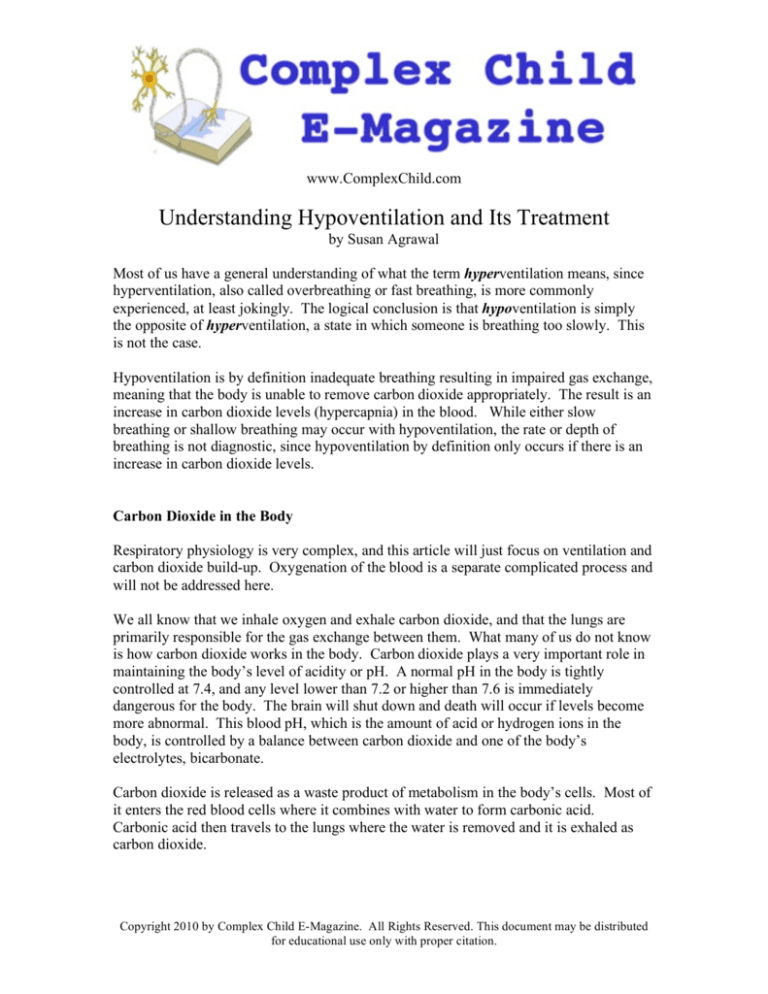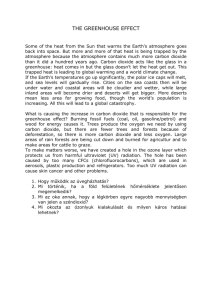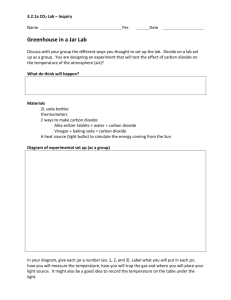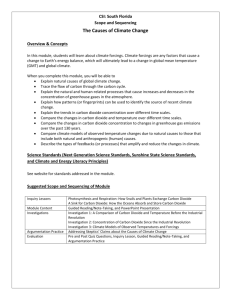
www.ComplexChild.com
Understanding Hypoventilation and Its Treatment
by Susan Agrawal
Most of us have a general understanding of what the term hyperventilation means, since
hyperventilation, also called overbreathing or fast breathing, is more commonly
experienced, at least jokingly. The logical conclusion is that hypoventilation is simply
the opposite of hyperventilation, a state in which someone is breathing too slowly. This
is not the case.
Hypoventilation is by definition inadequate breathing resulting in impaired gas exchange,
meaning that the body is unable to remove carbon dioxide appropriately. The result is an
increase in carbon dioxide levels (hypercapnia) in the blood. While either slow
breathing or shallow breathing may occur with hypoventilation, the rate or depth of
breathing is not diagnostic, since hypoventilation by definition only occurs if there is an
increase in carbon dioxide levels.
Carbon Dioxide in the Body
Respiratory physiology is very complex, and this article will just focus on ventilation and
carbon dioxide build-up. Oxygenation of the blood is a separate complicated process and
will not be addressed here.
We all know that we inhale oxygen and exhale carbon dioxide, and that the lungs are
primarily responsible for the gas exchange between them. What many of us do not know
is how carbon dioxide works in the body. Carbon dioxide plays a very important role in
maintaining the body’s level of acidity or pH. A normal pH in the body is tightly
controlled at 7.4, and any level lower than 7.2 or higher than 7.6 is immediately
dangerous for the body. The brain will shut down and death will occur if levels become
more abnormal. This blood pH, which is the amount of acid or hydrogen ions in the
body, is controlled by a balance between carbon dioxide and one of the body’s
electrolytes, bicarbonate.
Carbon dioxide is released as a waste product of metabolism in the body’s cells. Most of
it enters the red blood cells where it combines with water to form carbonic acid.
Carbonic acid then travels to the lungs where the water is removed and it is exhaled as
carbon dioxide.
Copyright 2010 by Complex Child E-Magazine. All Rights Reserved. This document may be distributed
for educational use only with proper citation.
2
Exhaling is usually a passive process. We use our muscles to inhale, and then allow them
to relax, which produces a passive exhalation to remove carbon dioxide. If the inhalation
is too shallow, too infrequent, or otherwise impaired, the exhalation is also affected,
meaning not all of the carbon dioxide may be expelled.
If there is too much carbon dioxide being retained in the body due to impaired respiratory
function, this causes the body’s pH to drop and become more acidic, creating a problem
called Respiratory Acidosis. This occurs through a simple biochemical process, which is
described in the next paragraph. Feel free to skip it if high school chemistry still vexes
you.
Since the body must always maintain a tight acid-base balance or pH, it compensates by
turning the carbon dioxide into bicarbonate in the blood. Bicarbonate then binds with the
excess acid (hydrogen ions), thereby reducing the acidic blood pH to a more normal
level. The following equation expresses these relationships.
Carbon dioxide + water = Carbonic acid = (Hydrogen ions) + Bicarbonate
or
CO2 + H2O = H2CO3 = (H+) + HCO3
If carbon dioxide begins to build up in a healthy person, he usually breathes faster and
deeper to help flush out the excess carbon dioxide. But when the respiratory system is
compromised, the body is unable to “blow off” the excess carbon dioxide through a
passive exhalation, and is also unable to maintain an appropriate pH without creating
bicarbonate.
Hypoventilation may also cause secondary hypoxemia or reduced oxygen saturation
levels (sats). This is because the alveoli, the tiny stretchy sacs in the lungs where the
exchange between oxygen and carbon dioxide occurs, may already be partially filled with
excess carbon dioxide that could not be exhaled. As a result, they cannot be filled
completely with oxygen, leading to low oxygen saturation levels, and creating additional
symptoms, such as poor sleep, shortness of breath, and fatigue. It is important to
recognize that hypoventilation is not simply diagnosed by these low oxygen saturations,
but instead by carbon dioxide retention measured as high levels of carbon dioxide in the
blood or during a sleep study. Low oxygen saturations are only a secondary symptom of
hypoventilation.
Causes of Hypoventilation
While there are many causes of hypoventilation, children with complex medical issues
usually have a neurological condition, neuromuscular disease, deformity of the chest or
spine, or are on medications that may reduce the drive to breathe.
Children with certain neurological conditions, including brain injuries, brain
malformations, nervous system diseases and similar other conditions, may experience
hypoventilation that is “central” in nature. This means that the brain or nervous system
3
does not control the process of breathing adequately. In some conditions, such as
Congenital Central Hypoventilation Syndrome, the automatic control of breathing is
completely absent, and the body fails to respond when carbon dioxide begins to
accumulate. Other neurological conditions and brain malformations may also cause
impaired control of breathing. If the brain does not tell the body to breathe adequately or
fails to normalize the gas exchange process, hypoventilation may occur.
Neuromuscular diseases, particularly those that weaken the muscles required for
breathing, also may cause hypoventilation. In this case, the weakened muscles cause
breathing to be shallow and ineffective. These children often first show symptoms at
night, since both respiratory drive and muscle tone are lower during sleep. As weakness
increases, symptoms may occur during the daytime as well.
Children with deformities of the chest wall or spine, including severe scoliosis and
kyphosis (rounded back), often experience hypoventilation. These children have a
restricted capacity to inhale and exhale due to the severity of their deformity.
Finally, medications used to treat conditions common to children with complex medical
issues, including pain, spasticity, and seizures, can cause hypoventilation by reducing the
body’s drive to breathe. Narcotic pain medication, benzodiazepines (such as Valium),
barbiturates (such as Phenobarbital), and other medications that cause altered
consciousness or sleepiness all may cause depressed central respiratory drive.
Symptoms and Diagnosis
Symptoms may be difficult to recognize at first, especially in children with multiple
medical issues. Early symptoms may include fatigue, daytime sleepiness, anxiety, and
shortness of breath. As the condition worsens, cyanosis (blue lips, fingers, and toes) or
paleness may occur. Severe disease may cause confusion, extreme fatigue, seizures, and
mental status changes, and may ultimately lead to impairment of other organs, including
pulmonary hypertension and cor pulmonale, a form of heart failure.
While slow or shallow breathing may be a sign of the condition, some children actually
breathe faster than normal in an attempt to “blow off” more carbon dioxide.
Common findings suggesting hypoventilation include:
•
•
•
•
•
High levels of CO2 (end tidal CO2) during a sleep study (usually >45-50 mm Hg)
Increased sodium bicarbonate (carbon dioxide) in the blood on routine electrolyte
lab tests (usually >30 mEq/L)
Lower oxygen saturations (<95%), especially during sleep
Elevated carbon dioxide in arterial blood (PaCO2) from blood gas analysis
(usually >45 mm Hg)
Low blood pH from arterial blood gas analysis (usually less than 7.4)
4
Note that low oxygen saturation levels may not always be caused by hypoventilation.
Children with complex medical issues may have other concurrent respiratory problems,
including chronic lung diseases, bronchopulmonary dysplasia, bronchiectasis,
pneumonia, bronchospasm from asthma, or difficulty coughing and managing secretions.
These concurrent conditions may be alternate causes of low oxygen saturation levels in
some children.
Treatment
The first attempt at treatment is to eliminate the cause of the problem. For example, a
child on a medication that depresses her respiratory drive, such as Valium, may be fine if
she is removed from the drug. Respiratory therapy should be used to improve underlying
respiratory functioning, such as keeping reactive airway disease under control and
maximizing secretion management using High Frequency Chest Wall Oscillation
(vibrating chest vest), suctioning, and medication. In some cases, corrective surgery,
either for a chest wall or spinal deformity, or to remove tonsils, adenoids, or other causes
of obstruction, may help to improve hypoventilation.
If treatment of the underlying cause is not possible or successful, assisted ventilation may
be necessary. Children who are routinely retaining carbon dioxide, with documented
high levels of carbon dioxide shown during a sleep study and on arterial blood gas
analysis, should be fitted with positive pressure ventilation, called CPAP or BiPAP.
These non-invasive ventilation devices consist of a mask or nasal pillows that keep the
airway open to deliver air to the alveoli in the lungs and to help remove carbon dioxide.
Many children only require CPAP or BiPAP while sleeping, though some children may
need to use it around the clock. Unfortunately, there are few other options if positive
pressure ventilation is not well-tolerated or appropriate pediatric-sized CPAP and BiPAP
equipment is unavailable. Some children with severe disease or other respiratory issues,
especially issues managing secretions, may require a tracheostomy and mechanical
ventilator.
The use of oxygen to treat hypoventilation is very controversial. Some children on CPAP
or BiPAP may need additional oxygen to maintain their oxygen saturations, and this is
perfectly fine. But oxygen should not be used alone as a treatment for moderate or severe
hypoventilation, particularly in children with neurological or neuromuscular diseases.
While supplemental oxygen may increase oxygen saturation levels, giving the false
impression that breathing has improved, it does not improve respiratory weakness or
central respiratory drive. In fact, supplemental oxygen may decrease the strength of
respiratory muscles and respiratory drive. Respiratory drive is often triggered by lack of
oxygen, and when that has been corrected by supplemental oxygen, the body is not
prompted to breathe faster or harder. In addition, supplemental oxygen may actually
increase the level of carbon dioxide in the body since many children are unable to “blow
off” the extra carbon dioxide that is produced from inhaling extra oxygen.
5
The use of supplemental oxygen in children with mild hypoventilation and other
concurrent respiratory problems may be beneficial if the oxygen does not cause an
increase in carbon dioxide levels. In these children, the benefits provided by the oxygen
for other conditions, such as underlying lung disease, may outweigh the risks. These
children must have their carbon dioxide levels closely monitored to detect any build-up
of carbon dioxide. Certain other children with mild disease, such as those with autism
who cannot tolerate CPAP, may also find the benefits of supplemental oxygen outweigh
the risks.
Hypoventilation can be treated, and its treatment may result in great improvements in
sleep, energy levels, and quality of life. All children with suspected hypoventilation
should be referred to a pediatric pulmonologist for evaluation.









